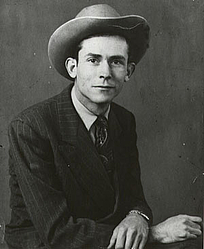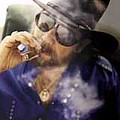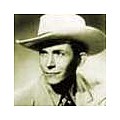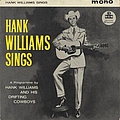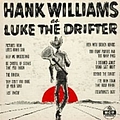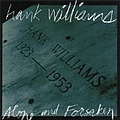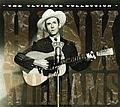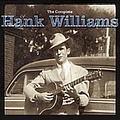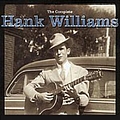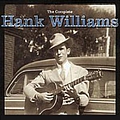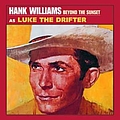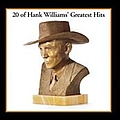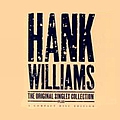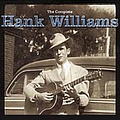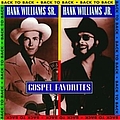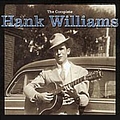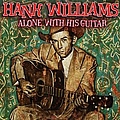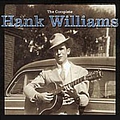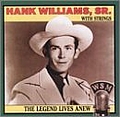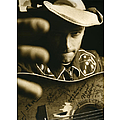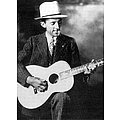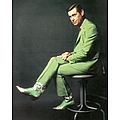Hank Williams Biography
On a warm night in June, 1949, with his first number one record spilling out of radios across the country, a frail young man walked onto the stage of Nashville's Ryman Auditorium for his Grand Ole Opry debut. Behind him lay nearly a decade of struggle and rejection in pursuit of this goal; ahead, a little more than five years in the limelight. By 1953, literally worn out at twenty-nine, Hank Williams was gone. But he had given country music much of its standard repertoire, a new definition of stardom and a legend so enduring that he is still the model for countless singers and songwriters. Born in Mount Olive West, Alabama (near Georgiana) on September 17th, 1923, Hiriam was the second child of Lon and Lillie Williams. Lon, a WWI veteran, was hospitalized during most of Hank's early life, leaving the boy's upbringing to his strong-willed mother. Small and fragile from the beginning (and afflicted with spina bifida), Hank may well have gravitated toward music as an alternative to sports. While living in Georgiana, he befriended Rufus Payne, a black street musician known as "Tee-Tot". Years later, Hank would say that Payne had given him "all the music training I ever had", and most biographers consider Payne the source of the noticeable blues thread running through Hank's music. Hear a sample of "Long Gone Lonesome Blues" At sixteen, living in Montgomery, Williams quit school and began his music career in earnest. He had made his first radio appearance on WSFA in late 1936 or early 1937, and would soon become one of the station's most popular performers. He also worked beer joints and regional shows with his band, already named the Drifting Cowboys. Lillie drove the group to venues in her station wagon and collected gate money. By the early 40s, Hank was one of the biggest draws in the region, and had come to the attention of several Nashville artists and music business luminaries. But his reputation as a singer was already matched by the one he'd built for drinking and unreliability. Most considered him an unsafe bet. In 1943 Hank met Audrey Mae Sheppard, an Alabama country girl with a two-year old daughter, Lycrecia, from a previous marriage. Audrey learned to play stand-up bass (well enough, anyway, to play in the band) and began acting as manager. They were married in December, 1944. She desperately craved a singing career, pushing for inclusion in the show at every chance. Her ambition, however, far exceeded her talent. Audrey would vie with Lillie for Hank's attention throughout the relationship. In 1946, she accompanied her husband to Nashville to meet publisher Fred Rose. Rose, in partnership with Roy Acuff, ran a successful "hillbilly" publishing concern (Acuff-Rose, later a giant in the industry) and at first was interested in Williams only as a writer. (Hank had begun writing songs shortly after he started singing and playing guitar, and sold songbooks at his club appearances.) Within the year, however, Rose had made Hank's singing career a pet project, and arranged for him to record four songs for the Sterling label. In March 1947, in a deal engineered by Rose, Hank signed with MGM. "Move It On Over" was his first MGM release and his first "Billboard" chart entry. He charted again in April, 1948 with "Honky Tonkin". Back home in Montgomery, Hank seemed poised for stardom; his regional popularity was higher than ever, bolstered now by his recording success. But he had entered the low arc of a repeating cycle that would haunt him for the rest of his days. More often than not, he showed up drunk (if at all) for live appearances, and was increasingly difficult for even his best friends to be around. Many, including Rose, gave up in frustration. Audrey filed for divorce in late April. With the big-time nearly in his grasp, Hank Williams was bottoming out. Hank's story could easily have ended there, but the Williamses reconciled, the relationship with Rose was mended, and Rose set about finding an avenue for greater exposure. Decision makers at the Opry were still wary, but KWKH in Shreveport, Louisiana was interested in the emerging star for their Saturday night jamboree, the Louisiana Hayride, and Hank joined the show in August. "A Long Gone Daddy" had recently reached number six, but his next four releases failed to chart, and a fifth, "Mansion On The Hill," stopped short of the top ten. KWKH's fifty-thousand watts were putting Williams in living rooms all across the eastern US every Saturday night, but his records were falling flat. Had he peaked? Was he, after all, only middling-star material? Nearly fifty years later, in a world where today's icon is tomorrows inconsequential, it is difficult to imagine a song so igniting radio listeners that it holds the top spot on the charts for sixteen weeks. No one in Hank's circle wanted him to waste time or tape on "Lovesick Blues". The song was a throwaway, they said; a piece of fluff that was more likely to damage his career than to enhance it. Hank was insistent, though, and the song was given two quick passes at the end of a session. Released in February, 1949, it was number one -and more- by early May. "Lovesick Blues" was an "event"; popular beyond precedent, imagination or belief. And, suddenly, Hank Williams was big. Big enough, at last, for the Opry. With success came increased creative freedom. Hank's "mainstream" songwriting and recording efforts continued to do extremely well, but he also delved into remorseful gospel themes and a series of recitations under the transparent pseudonym "Luke The Drifter". Hank the writer often seemed preoccupied with mortality and the futility of human relationships- his marriage to Audrey was now in steady decline, and those who knew him could easily see the real-life parallels in songs like "You're Gonna Change (Or I'm Gonna Leave), "Why Don't You Love Me" and "Cold, Cold Heart". Clearly, here was a man displaying his demons for all to see. Hank didn't have to "interpret" sad songs; he had only to sing from his heart. For a time, fame and fortune staved off the consequences of his self-destructive lifestyle. By mid 1952, however, his life was coming apart at the seams. Audrey had filed for divorce again, this time for good. Wracked with back pain, he was dependent on alcohol and, it is believed, morphine. Often missing or too drunk to perform at curtain time, he was fired by the Opry, and headed back to the Hayride in Shreveport. In his final weeks, Hank spun hopelessly out of control. Even his marriage to pretty young Billie Jean Jones couldn't slow his headlong plunge. Sometime after midnight on New Year's Day, 1953, sleeping in the back seat of his Cadillac en route to a show, Hank Williams fulfilled the prophecy of his own "I'll Never Get Out Of This World Alive". Three of Hank's recordings reached the top of the charts in the year following his death. By 1954, his earthly voice silenced, the fragile young man from Alabama was only a legend. But in his last few torrid years, he had changed country music forever and his musical legacy remains its cornerstone. GregorPocivalsek Well, back in '52, Mr. Hank Williams was kicked out the Opry fer drinkin' and bein' a badass. It's just too bad that he died before he could be reinstated. So now, Hank III, is helping us all out by supporting a campaign to get him back where he belongs. So, all fans of Hank and his classic sound, that has influenced generations of Rock and Country musicians, please follow this link to sign the petition. http://www.myspace.com/reinstatehankwilliams
Top Hank Williams Lyrics
Write a comment
What do you think about Hank Williams? Let us know in the comments below!
Hank Williams News & events
Top Hank Williams Albums
Similar artists
- Hank Williams IiiCountry/Punk
- Jimmie RodgersBlues/Country/Folk
- George JonesCountry
- Wayne HancockCountry
- Merle HaggardCountry
- Ernest TubbCountry
- Lefty FrizzellCountry
- Waylon JenningsCountry
- Roy AcuffCountry
- Townes Van ZandtCountry/Folk
